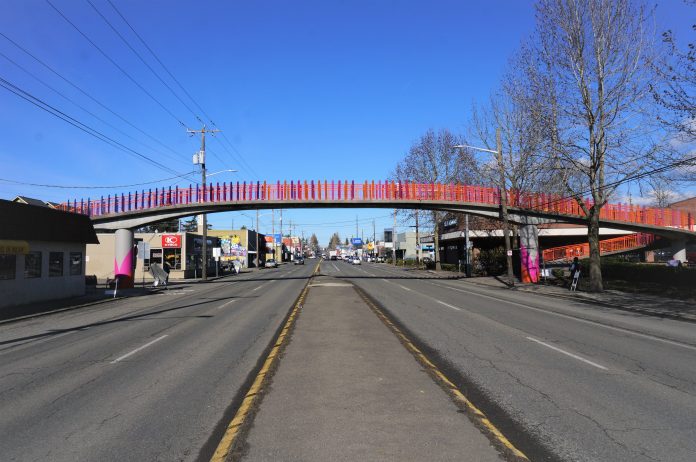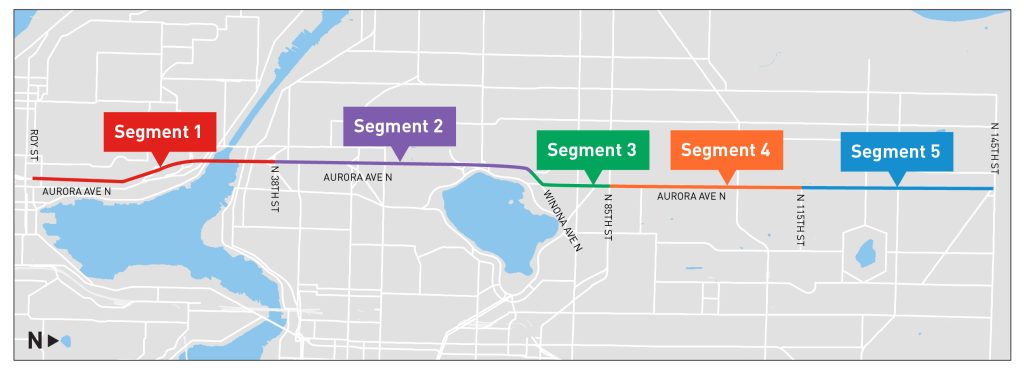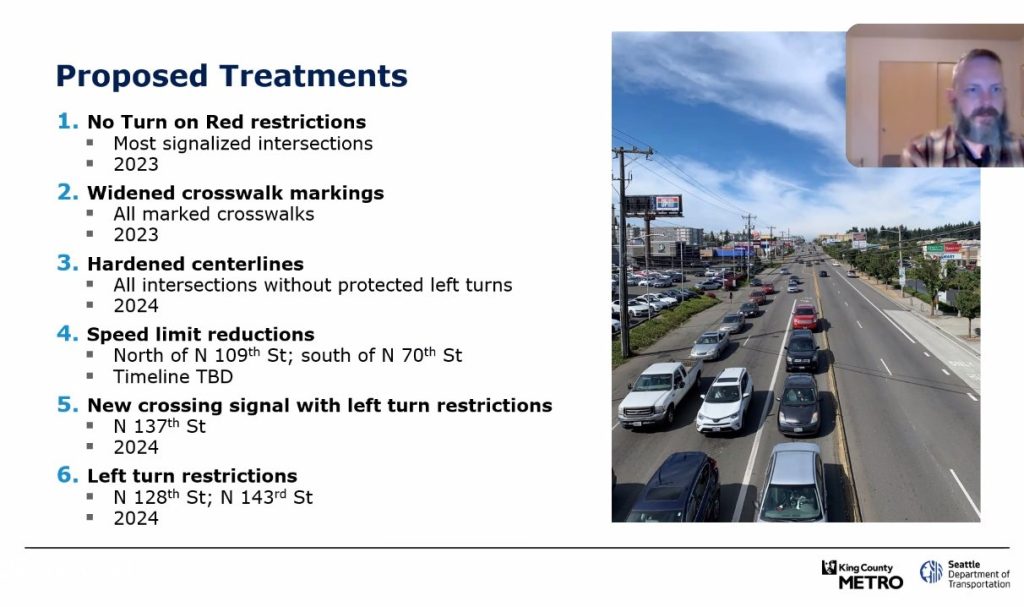
After including a much-celebrated $50 million allocation for Seattle’s deadliest state highway, Aurora Avenue N, in the 2022 Move Ahead Washington transportation package, the state legislature adopted a budget this year that doesn’t anticipate actually allocating that funding anytime soon. If signed by Governor Jay Inslee as expected, the 2023-2025 state transportation budget, which lays out spending expectations well beyond those two years, doesn’t include funding for the safety-related revamp of State Route 99 in Seattle until at least 2029, but potentially even later than that.
The move is a setback for efforts to radically redesign at least one segment of the eight-mile corridor where more than 20 people were either killed or seriously injured in 2022. The legislature initially directed the City of Seattle to focus on the segment of the corridor between N 90th Street and N 105th Street, in the middle of the city’s Aurora-Licton Urban Village growth center. But the City is taking a broader view of the entire corridor, utilizing a previously-obtained state grant to conduct a full corridor study, looping in King County Metro to evaluate transit-related improvements and Seattle Public Utilities to look at watersheds and drainage.
Governor Inslee’s proposed budget released in December, by contrast, had included an initial $1 million for the project over the next two years, with the bulk of the remaining funds allocated between 2025 and 2029. This would have been roughly in line with the expectation that the legislature set last year, with language inside the Move Ahead package stipulating that all state-funded improvements would need to wrap up by the end of 2029.

Signs that the legislature might not be eager to fund the Aurora project, the most expensive of all of the individually called-out bicycle and pedestrian-oriented projects in Move Ahead, were there before the session even started. In December, the Washington State Department of Transportation’s (WSDOT’s) active transportation division provided a list of how all of those projects could be ranked, as directed by the legislature last year, allowing for potential prioritization. The rankings, which used the Washington Department of Health Environment Health Disparities Map, placed the Aurora project as a whole in the middle of three tiers of rankings, with projects like Kent’s “Meet Me on Meeker” and the Barnes Creek Trail South Segment in Des Moines, which were prioritized for funding in this biennial budget, ranked in the highest-priority first tier.
But that ranking simply incorporated geographic location, and didn’t look at what each project was actually expected to accomplish.
“The time and staff capacity available for this work didn’t allow for a deep analysis of the 43 projects on the list for effects beyond their immediate location,” Barb Chamberlain, director of the active transportation division, told The Urbanist in December. “That would have required examination of land use, housing and employment, and many other factors on every project.”
In other words, nothing in the project ranking takes into account the potential impact the projects could have on reducing serious injuries and fatalities. Furthermore, the ranking looked at Aurora as an entire corridor, rather than the targeted segment between N 90th Street and N 105th Street. Chamberlain noted that the entire project runs through several census tracts, some with environmental health disparities of 8 or 9, and others with scores of 3 or 4, producing that average score that ranked the project in the middle of the list.
But the entire corridor upgrade wouldn’t happen at once, and so it’s not clear that the report accurately captured any of the potential impact of the project. Of course, the entire list of 43 bike and pedestrian projects, estimated at $296 million, nearly matches the amount Washington is set to allocate for one highway project, the Interstate Bridge Replacement between Washington and Oregon, over the next two years.
But the legislature has the potential to revisit its funding timelines in the near future. “This is definitely something we can keep working on. This isn’t the end-of-the-line,” Representative Liz Berry (D-36), who represents a district that touches Aurora and is the only Seattle representative on the House transportation committee, told The Urbanist. “I think with renewed focus on this project, we can definitely make the case to unleash funding sooner than 2029.”
While the city could decide to pursue funding for full-corridor upgrades on its own, either in parallel with any potential state funding in the future or in the event that it stays delayed indefinitely, the Seattle Department of Transportation (SDOT) confirms the plan at the moment is to wait for funding.
“We are currently in the planning phase to develop a preferred concept design which is supported by the WSDOT Pedestrian and Bicycle Program grant,” SDOT’s Mariam Ali told The Urbanist. “Beginning the design or construction of full corridor reconstruction (between N 90th St and N 105th St) will be dependent on the timeline of when the state appropriates the funds from the Move Ahead Washington package.”
But some spot improvements are still moving forward. At a meeting of the Fremont Community Council in March, SDOT’s Brian Dougherty, leading the Aurora corridor project study, detailed how the department would be utilizing $1 million in local Vision Zero dollars for some near-term improvements to the corridor. This year, right-turn-on-red restrictions will be implemented at most signalized intersections along the corridor, and crosswalk markings will be widened where they exist already. And then next year, the city will add hardened centerlines, which direct drivers to not cut corners when making turns, to intersections where pedestrians share crosswalks with turning drivers. The department will also be adding a pedestrian crossing at N 137th Street, and restricting left turns across pedestrian crosswalks at N 128th Street and N 143rd Street.

Advocates are focusing their energy on the City of Seattle to ensure that improvements to Aurora happen. The Aurora Reimagined Coalition, a coalition of neighborhood residents, employees, and community organizations advocating for a bold remaking of the entire corridor, posted an update last week about a potential path forward.
“We know that SDOT is already looking at other sources of funding for improvements to Aurora – the $50 million is insufficient for any more than a small segment of the corridor. With this delay in appropriating the $50 million funding for the Licton Springs demonstration project, securing other sources of funding has become more important for the short-term progress of improvements along Aurora,” the post stated.
There will likely be a considerable push to include larger safety upgrade funding in Seattle’s next transportation levy, set to go to the voters next year, but utilizing that funding to upgrade a state highway, rather than the laundry list of city streets that also need attention, could represent a big missed opportunity.
“We can expect a complete transportation vision for all of Aurora by the end of 2024. The Aurora Reimagined Coalition will be pushing SDOT and the Mayor’s Office to make this vision as bold and transformative as possible. Once a formal vision for the corridor is on the books, it will be much easier to apply for funding from state and federal sources to realize that vision,” the coalition’s statement read.
With the state legislature prioritizing other areas ahead of efforts to reduce traffic deaths through legislation, the budget also seems to reflect those priorities. But it may take the City of Seattle stepping up to show that the vision for how to remake Aurora is achievable and within reach for the legislature to actually decide to take out their debit card.
Ryan Packer has been writing for The Urbanist since 2015, and currently reports full-time as Contributing Editor. Their beats are transportation, land use, public space, traffic safety, and obscure community meetings. Packer has also reported for other regional outlets including BikePortland, Seattle Met, and PubliCola. They live in the Capitol Hill neighborhood of Seattle.

